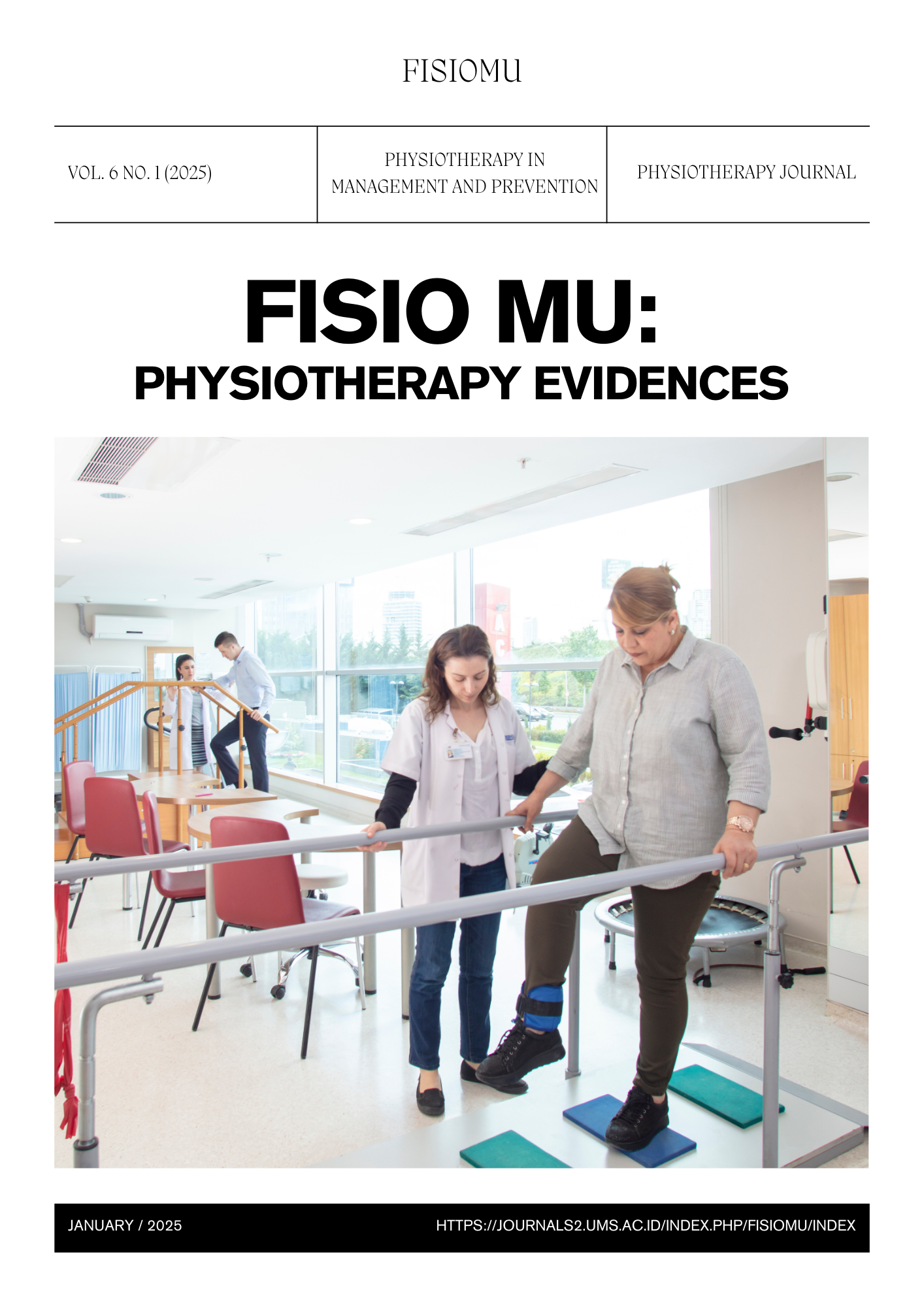Correlation Analysis Between Cardiovascular Load and Lung Function Disorders Based On FVC Values In Construction Workers
DOI:
https://doi.org/10.23917/fisiomu.v6i1.7390Keywords:
cardiovascular load, pulmonary impairment, FVC, construction workersAbstract
Introduction: Construction work environments, often characterized by exposure to dust and chemicals, pose significant risks to workers' respiratory and cardiovascular health. While much research has focused on the impact of dust on lung function, the role of cardiovascular load in contributing to these health issues remains underexplored. This study aimed to analyze the correlation between cardiovascular load (%CVL) and pulmonary function impairment based on forced vital capacity (FVC) in construction workers. Methods: This observational cross-sectional study involved 37 construction workers in Central Jakarta, selected through purposive sampling. Data were collected via spirometry and heart rate measurements before, during, and after work. Results: The results showed that 79% of respondents had restrictive disorders, while 21% had obstructive disorders. Statistical analysis revealed a significant negative correlation between %CVL and FVC values (p < 0.001; r = -0.550). These findings indicate that increased cardiovascular load is associated with decreased lung function, particularly in workers with long-term exposure to dust and extended work durations. Conclusion: Managing physical workload and controlling workplace environments are crucial to preventing pulmonary function decline in construction workers.
Downloads
References
Albert, C. and García-Serrano, C. (2010) ‘Cleaning the slate? School choice and educational outcomes in Spain’, Higher Education, 60(6), pp. 559–582. Available at: https://doi.org/10.1007/s10734-010-9315-9. DOI: https://doi.org/10.1007/s10734-010-9315-9
Cullinan, P. et al. (2017) ‘Occupational lung diseases: from old and novel exposures to effective preventive strategies’, The Lancet Respiratory Medicine, 5(5), pp. 445–455. Available at: https://doi.org/10.1016/S2213-2600(16)30424-6. DOI: https://doi.org/10.1016/S2213-2600(16)30424-6
Fishwick, D., Barber, C.M. and Darby, A.C. (2010) ‘Review series: Occupational and environmental lung disease: Chronic obstructive pulmonary disease and the workplace’, Chronic Respiratory Disease, 7(2), pp. 113–122. Available at: https://doi.org/10.1177/1479972309354690. DOI: https://doi.org/10.1177/1479972309354690
Hnizdo, E. (2002) ‘Association between Chronic Obstructive Pulmonary Disease and Employment by Industry and Occupation in the US Population: A Study of Data from the Third National Health and Nutrition Examination Survey’, American Journal of Epidemiology, 156(8), pp. 738–746. Available at: https://doi.org/10.1093/aje/kwf105. DOI: https://doi.org/10.1093/aje/kwf105
Kemnaker (2016) Statistik Ketenagakerjaan Indonesia. Kementerian Tenaga Kerja Republik Indonesia.
De Matteis, S. et al. (2017) ‘Current and new challenges in occupational lung diseases’, European Respiratory Review, 26(146), p. 170080. Available at: https://doi.org/10.1183/16000617.0080-2017. DOI: https://doi.org/10.1183/16000617.0080-2017
Momtazmanesh, S. et al. (2023) ‘Global burden of chronic respiratory diseases and risk factors, 1990–2019: an update from the Global Burden of Disease Study 2019’, eClinicalMedicine, 59, p. 101936. Available at: https://doi.org/10.1016/j.eclinm.2023.101936. DOI: https://doi.org/10.1016/j.eclinm.2023.101936
NEGAR, A.S. (2024) ‘Cardiovascular disorders and exposure to chemical pollutants’, J PREV MED HYG, 65.
Sohrabi, Y. et al. (2022) ‘Pulmonary function and respiratory symptoms in workers exposed to respirable silica dust: A historical cohort study’, Heliyon, 8(11), p. e11642. Available at: https://doi.org/10.1016/j.heliyon.2022.e11642. DOI: https://doi.org/10.1016/j.heliyon.2022.e11642
Tavakol, E. et al. (2017) ‘Risk Evaluation of Construction Workers’ Exposure to Silica Dust and the Possible Lung Function Impairments’, National Research Institute of Tuberculosis and Lung Disease, 16(4).
Vinnikov, D. et al. (2023) ‘Occupational exposure to fine particulate matter in the reinforced concrete production and its association with respiratory symptoms and lung function’, BMC Public Health, 23(1), p. 1813. Available at: https://doi.org/10.1186/s12889-023-16753-x. DOI: https://doi.org/10.1186/s12889-023-16753-x
World Health Organization (2019) Occupational Health: A manual for primary healthcare workers.
Downloads
Submitted
Accepted
Published
How to Cite
Issue
Section
License
Copyright (c) 2024 Fisio Mu : Physiotherapy Evidaces Journal

This work is licensed under a Creative Commons Attribution-NonCommercial-NoDerivatives 4.0 International License.

This work is licensed under a Creative Commons Attribution-NonCommercial 4.0 International License.
Authors who publish with FISIO MU: Phsiotherapy Evidences agree to the following terms:
- Author(s) retain copyright and grant the journal right of first publication with the work simultaneously licensed under a Creative Commons Attribution-NonCommercial 4.0 International License that allow others to share the work within an acknowledgement of the work’s authorship and initial publication of this journal.
- Author(s) are able to enter into separate, additional contractual arrangement for the non-exclusive distribution of the the journal’s published version of the work (e.g. acknowledgement of its initial publication in this journal).
- Author(s) are permitted and encouraged to post their work online (e.g. in institutional repositories or on their websites) prior to and during the submission process, as it can lead to productive exchanges, as well as earlier and greater citation of published works.












